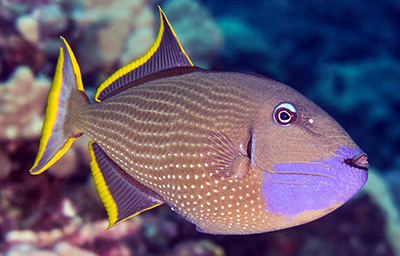For today’s post, I’d like to elicit your thoughts on an interesting phenomenon I’ve observed in my aquarium, specifically involving an aggravating repetitive behavior exhibited until fairly recently by my pair of blue-throat triggerfish (Xanthichthys auromarginatus).
Allow me to set the stage: I introduced the blue-throats to my 125-gallon about a year and a half ago when it was still a FOWLR system. Their tankmates at the time included a one-spot foxface (Siganus unimaculatus), yellow tang (Zebrasoma flavescens), tomato clownfish (Amphiprion frenatus), and sixline wrasse (Pseudocheilinus hexataenia).
The repetitive behavior I’m referring to—and both the male and female exhibited it—was repeatedly swimming around the base of a powerhead mounted at the far left end of the tank (as I usually face it—you can actually view the tank from either side and one end) about 5 inches below the surface. They would swim in a circle 10, 15, even 20 times or more, briefly break away and swim about half the length of the tank, and then come right back to the powerhead to swim another set of “laps.”
Both triggers fed with gusto and would swim up to greet me whenever I approached the tank, no doubt assuming more food was forthcoming, and sometimes they would stop the lap swimming and explore more of the tank for brief periods. But they would always revert to that same maddening behavior.
I tried moving the powerhead next to my overflow box and closer to the surface so it would be harder to swim in a loop around it, but the triggers just wiggled their way through the narrowed pathway anyway. Afraid they’d get injured or flip out of the tank, I moved the powerhead back to its original location.
Perseverative behavior like this in any animal (such as frenetic pacing in zoo mammals) often indicates stress. But what was the cause? The tank is sufficiently large and they had open swimming space all around the perimeter of the tank and through a channel running between two peaks of rockwork, so it wasn’t the case that they were constrained and couldn’t expend energy. The other fish pretty much ignored them completely, so tankmate aggression wasn’t the problem either. Neither trigger exhibited signs of disease nor subsequently became ill. Of course, I’m always pretty fanatical about maintaining excellent water quality and feeding a well-balanced diet, so it’s safe to scratch those factors off the list as well.
Now, about a year ago, I began to transition my 125-gallon from a FOWLR system to a reef system. I first added just a handful of corals from the 75-gallon reef tank I was shutting down at the time, and I later got a nice assortment of gorgonians and corals (not to mention a beautiful Atlantic blue tang) from Caribbean Chris, who was tearing down his tank in anticipation of his move to Florida.
Then a funny thing happened. I can’t say precisely when, but at some point during or after the addition of sessile invertebrates to the 125-gallon, the triggers’ repetitive behavior stopped—and I mean stopped completely. In fact, it’s safe to say they don’t even give that powerhead they were so fixated upon a second glance anymore. Today they regularly cruise the entire tank and exhibit no signs of nervous energy. This behavioral change was pretty stark, and once again I find myself questioning the cause.
I have a theory on this, which is loosely based on the idea that the closer to natural the aquarium environment is, the better for the fish from a psychological standpoint, but I’m more interested in hearing what you have to say on the subject. If you have an opinion or similar experience to share, please do so in the comment section below.



